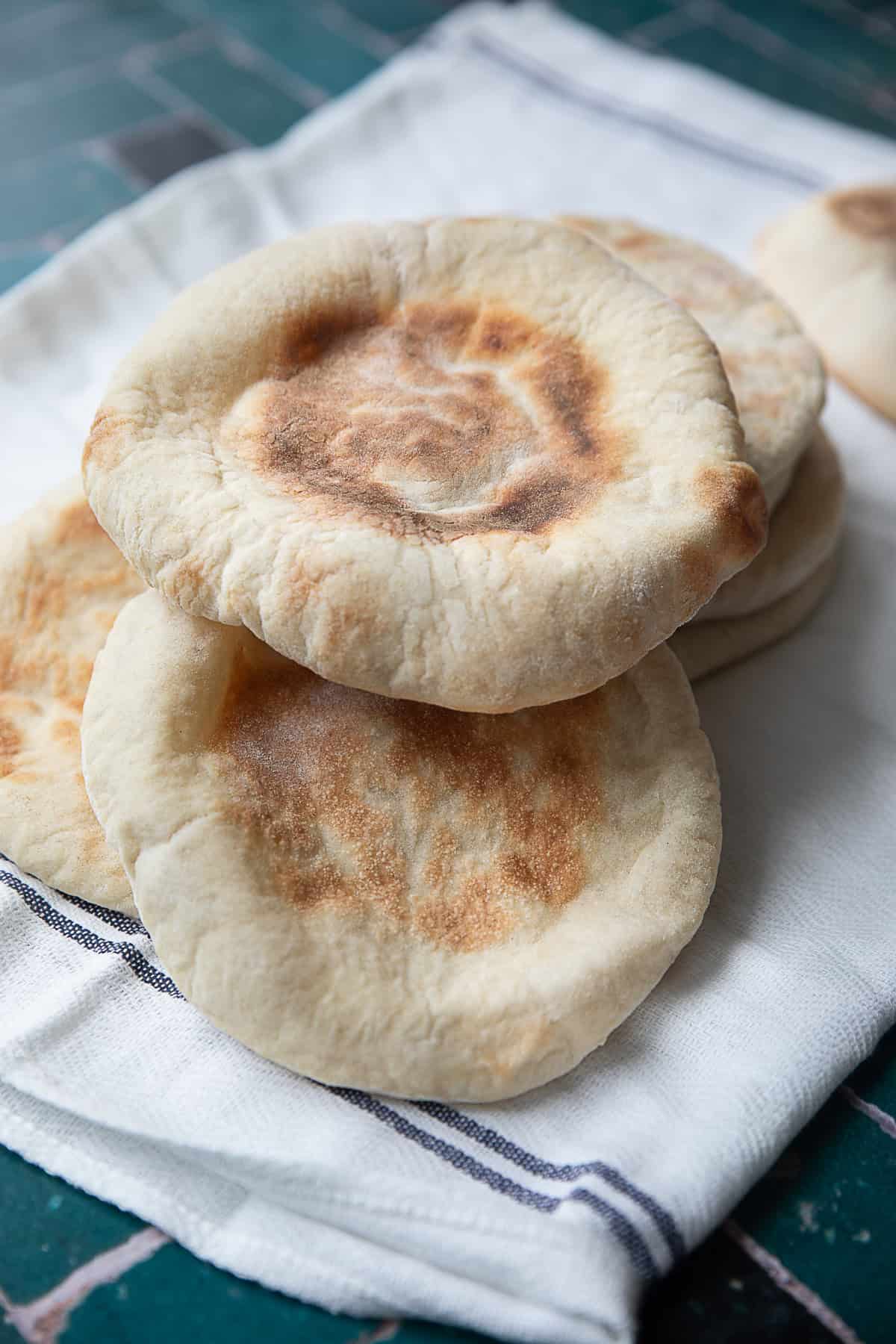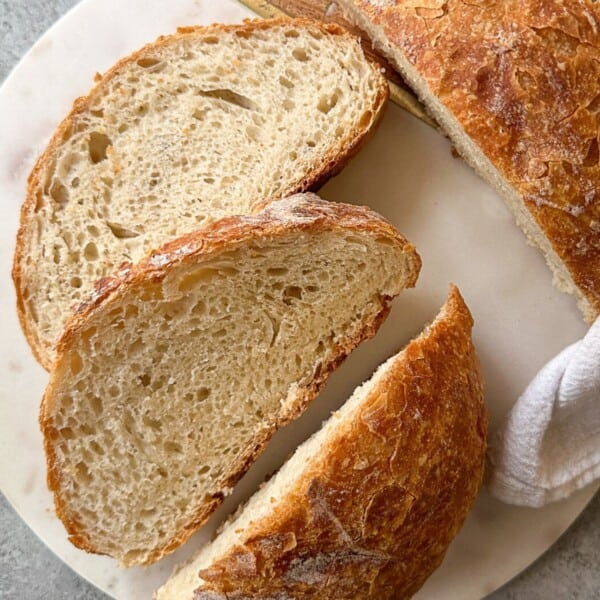This post may contain affiliate links.
Pita bread is a beloved staple of Middle Eastern cuisine, known for its soft, pillowy texture and signature pocket. With a golden exterior and a light, airy interior, this versatile flatbread is perfect for scooping up dips, stuffing with savory fillings, or serving alongside your favorite meals.

Traditionally baked at high temperatures, pita bread puffs up in the oven, creating an ideal pocket for all kinds of delicious fillings. Making homemade pita bread is easier than you might expect. Once you try this recipe at home, you may never go back to store-bought!
I love making homemade bread; it is a worthwhile experience that fills the kitchen with a warm, aromatic delight and a sense of comfort. I recommend you try my khubz arabi, easy no-yeast flatbread, lavash bread, and bazlama easy Turkish flatbread recipes.
Recipe Highlights
Cultural Influence: Middle Eastern staple
Primary Cooking Technique: High-heat baking for a soft, pillowy texture with a signature pocket
Dominant Flavor Profile: Mild, with a subtle richness from olive oil
Skill Level Required: Beginner-friendly

Why This Recipe Works
We all have had those lovely pita pockets at Middle Eastern and Mediterranean restaurants. I’m talking about those airy and light breads that are hollow in the middle and stuffed with all the good stuff.
You’ve probably also tried the store-bought ones, but let me tell you, nothing beats the warmth and freshness of homemade pita bread that elevates any meal.
This recipe is surprisingly easy to follow, making it accessible even for beginners. My pita bread recipe is versatile, delicious, and perfect for any occasion.
It’s so much fun to make your own bread at home and have freshly baked bread with your meals, especially if you’re having a Mediterranean feast or adding a homemade touch!
Ingredients

- All-Purpose Flour: Using all-purpose flour provides the perfect balance between strength and tenderness. It helps the pita puff up beautifully while maintaining a soft texture.
- Instant Yeast: It works quickly, meaning no need for proofing, making the dough rise faster. If you use active dry yeast, make sure to dissolve it in warm water with just a bit of sugar before adding it to the dry ingredients. Read about active dry yeast vs instant yeast on The Kitchn.
- Granulated Sugar: A small amount of sugar helps feed the yeast, ensuring the pita bread rises perfectly. It also adds a hint of sweetness to balance the flavors.
- Salt: In addition to enhancing the flavor, it also strengthens the gluten structure in the dough, making your pita chewy and flavorful.
- Extra Virgin Olive Oil: It adds a rich, slightly nutty flavor while also keeping the bread soft and pliable.
- Water: It should be warm to the touch, but not hot. Warm water activates the yeast and helps the dough rise quickly, creating the perfect airy texture for pita bread.
Instructions
Step 1: Prepare the Dough
Place the flour, instant yeast, sugar, and salt in the bowl of a stand mixer and whisk to mix. Pour the olive oil and warm water into the bowl and start mixing on medium speed using the dough hook.

Step 2: Let the Dough Rise
Once the dough has come together, shape it into a ball and place it in a bowl. Cover with a towel and let it rise for one hour until it doubles in size.


Step 3: Pre-Shape the Dough
Place a pizza stone or a baking sheet in the oven and preheat the oven to 500°F.
Take the dough out of the bowl and divide it into eight pieces. Cover with a kitchen towel and let the dough balls rise for another 15 minutes.

Step 4: Shape the Dough
Take a dough ball while keeping the others under the towel and shape it into a ball.
Then press gently with your fingers to make it into a round disk without tearing it or letting the air out. Using a rolling pin, gently roll out the dough until it’s no thicker than ¼ inch.

Step 5: Bake the Bread
Place the rolled dough on the hot surface in the oven and bake for two minutes. The bread will start to puff. Flip and bake for another minute.
Place the freshly baked pita on a plate and cover with a towel so it won’t dry. Continue with the remaining dough.


How to Serve Pita Bread
Whether served warm or toasted, Pita bread is an incredibly versatile classic Middle Eastern bread and pairs well with various dishes.
For a delightful mezze platter, serve pita bread with an assortment of dips such as tzatziki sauce, melitzanosalata, spicy hummus, baba ganoush, labneh, and muhammara. The soft, pillowy texture of pita complements these flavors perfectly, making it an ideal choice for dipping.
Whether served warm or toasted, pita bread is perfect for creating pockets and sandwiches. Try filling pita pockets with savory options like beef shawarma, lamb shawarma, chicken shawarma, homemade falafel, shish tawook, chicken gyro, or chicken souvlaki.
Add toum, zhoug, and pickled turnips to your sandwich or wrap for a flavorful twist. You can even opt for a vegetarian version with Lebanese spicy potatoes (batata harra).
You can also use it to make arayes or transform it into pita chips for dipping into homemade hummus. Its versatility ensures that pita bread enhances every meal with its delicious, adaptable nature.

Making Pita Chips
Crispy pita chips is like Middle Eastern croutons! You can add it to different salads, the most popular being fattoush salad. It’s so delicious, easy to make, and adds extra crunch to your salads.
To make crispy pita bread, follow the simple instructions below:
First, heat olive oil in a pan. Then, tear the bread into bite-size pieces.
After that, fry in the olive oil with some salt and sumac. Finally, place on paper towels to get rid of excess oil.
Recipe Tips
- Use Warm Water: Make sure to use warm water (around 110°F) to activate the yeast. If it’s too hot, it can kill the yeast; too cold, and the dough won’t rise as well.
- Let the Dough Rest: After dividing it into portions, allow the dough to rest for 15 minutes. This will make rolling out the pita easier, ensuring an even texture.
- Bake on a Hot Surface: For the best pita puff, bake it on a hot surface like a pizza stone or a preheated baking sheet. Make sure that the surface is thoroughly heated to achieve that perfect crispy exterior and soft inside.
- Cover Baked Pita: Once the pita is baked, place it under a towel to keep it soft and prevent drying out. This will maintain the pillowy texture of the pita.
- Handle the Dough Gently: Once the dough has doubled in size after one hour, don’t punch it down. The dough needs the air to puff and be hollow in the middle. While rolling, make sure you’re not pressing the rolling pin on the dough; but roll it on the dough without much pressure.
- Bake One at a Time: This recipe yields 8 pita breads. To maintain their quality, I baked them one by one, rolling out one while waiting for the other one to bake. You can do two at a time, these don’t take much time to bake anyway.

Variations and Substitutes
Gluten-Free Pita: Use 1:1 gluten-free flour blend designed for baking. Keep in mind that the texture may differ slightly.
Olive Oil Substitutes: Instead of extra virgin olive oil, you can use regular olive oil or avocado oil.
Herbed Pita: Enhance your pita with the addition of herbs like oregano, thyme, or za’atar mixed into the dough. This adds a fragrant flavor that is perfect for Mediterranean dishes.

Storage
Room Temperature: Place the pita in an airtight plastic bag or wrap it tightly with plastic wrap to maintain freshness. Store pita bread at room temperature for up to 3 days.
Refrigerator: If you plan to store pita bread for up to a week, keep it in the fridge. Wrap the pita in plastic wrap or place it in an airtight container. When ready to serve, reheat in a warm oven or on a skillet to bring back its softness.
Freezer: For longer storage, separate each pita with a layer of parchment or wax paper to prevent them from sticking together. Wrap the stack tightly in aluminum foil, or place the pita in a freezer-safe plastic bag.
Reheating Frozen Pita: To reheat frozen pita bread, allow it to thaw in the fridge or at room temperature. Preheat the oven to 250°F, wrap a few pita breads in an aluminum foil, and place them in the oven for about 10-12 minutes until they’re fully warm. Serve immediately.
Frequently Asked Questions
I recommend sticking to the recipe to get perfect results. However, if you need to use whole wheat flour, I suggest using only one cup and using all-purpose flour for the rest.
You can turn it into pita chips. Follow my instructions to make delicious pita chips and serve with your favorite dip!
Sometimes this bread can get pretty hard if it hasn’t been stored properly, but you can still salvage it. Just wrap the hardened bread in a damp towel and heat in the oven at 350°F for 7-10 minutes. It will come out super fresh and soft!
I used a stand mixer with a dough hook to make the dough. However, you can mix by hand in a large bowl works just as well. Choose whichever method suits your kitchen setup and preference.
Homemade pita is best to serve and eat fresh, however, you can store it easily. Wrap them tightly in a plastic bag or store them in an airtight Ziploc bag and keep them at room temperature for up to 2 days.
More Bread Recipes
Did you make this recipe? I’d love to hear about it! Please comment and leave a 5-star🌟 rating below. You can also follow us on Instagram, Facebook, Pinterest or subscribe to our newsletter to get a free e-Cookbook!

Homemade Pita Bread Recipe
Ingredients
- 2¾ cups all purpose flour
- 2 teaspoons instant yeast
- 1 teaspoon granulated sugar
- 1 teaspoon salt
- 3 tablespoons olive oil , extra virgin
- 1 cup warm water
Instructions
- Put flour, yeast, sugar, and salt in a stand mixer and mix.
- Add olive oil and water. Mix until the dough is formed. It can be a little sticky. Add a little flour if needed.
- Cover and rest for 1 hour so the dough is doubled in size. Do not punch the dough down.
- Preheat the oven and a pizza stone to 500℉.
- Divide the dough into eight pieces and cover for 15 minutes to rise.
- Take one dough ball and keep the rest covered.
- Use your fingers to shape the dough into a disk and don't let the air out. Gently roll out the dough using a rolling pin. The disk shouldn't be thicker than ¼ inch.
- Place the rolled disk on the hot pizza stone (or baking sheet) and close the oven door. Let it bake for two minutes, it will puff.
- Flip the bread and bake for another two minutes.
- Place the baked pita bread on a plate and cover with a towel.
- Continue baking the remaining pita breads.
- Store tightly in a plastic bag.
Notes
- Use Warm Water: Make sure to use warm water (around 110°F) to activate the yeast. If it’s too hot, it can kill the yeast; too cold, and the dough won’t rise as well.
- Let the Dough Rest: After dividing it into portions, allow the dough to rest for 15 minutes. This will make rolling out the pita easier, ensuring an even texture.
- Bake on a Hot Surface: For the best pita puff, bake it on a hot surface like a pizza stone or a preheated baking sheet. Make sure that the surface is thoroughly heated to achieve that perfect crispy exterior and soft inside.
- Cover Baked Pita: Once the pita is baked, place it under a towel to keep it soft and prevent drying out. This will maintain the pillowy texture of the pita.
- Handle the Dough Gently: Once the dough has doubled in size after one hour, don’t punch it down. The dough needs the air to puff and be hollow in the middle. While rolling, make sure you’re not pressing the rolling pin on the dough; but roll it on the dough without much pressure.
- Bake One at a Time: This recipe yields 8 pita breads. To maintain their quality, I baked them one by one, rolling out one while waiting for the other one to bake. You can do two at a time, these don’t take much time to bake anyway.
Nutrition
Nutrition information is automatically calculated, so should only be used as an approximation.














Excellent recipe – exactly what I was looking for! I love hummus and needed some bread to eat it with and this pita bread recipe really hit the spot!
The bread turned out soft, fluffy, and full of flavor. It was surprisingly easy to make and tasted so much better than store-bought pita. I will definitely be making this again!
Homemade is always the best! I can’t wait to try this recipe soon. 🙂
This fresh, homemade pita looks fabulous. It’s not as complicated to make as I thought it would be. I will be trying this recipe ASAP!
The 2nd attempt using this recipe worked like a charm. After procuring a pizza stone the oven end of the process turned out beautifully, nice puffy pitas very-very slightly browned. I also carefully used a tortilla press instead of hand rolling and found it to be much faster, cleaner and produced the more evenly shape/size pita I prefer. Using parchment discs on a cast iron press made lifting them free and easy to then move to the oven. Turns out it took me roughly 2 mins to press out a pita so in the time taken to cook 2 in the oven. My next 2 would be ready to go, so cooking tow at a time sped things up nicely. A good recipe. It’s one of Shadi’s that I’ve bookmarked. Thanks!
Hi Scott! Thank you for your comment and I’m glad you enjoyed this recipe! I love the idea of using a tortilla press and bet that would speed up things, might give it a try myself as well!
This recipe worked really well! I’ll definitely make pita bread again!
These homemade pitas are a fun weekend baking project!
These came out perfect! So fluffy and delicious -impossible to resist when they’re warm!